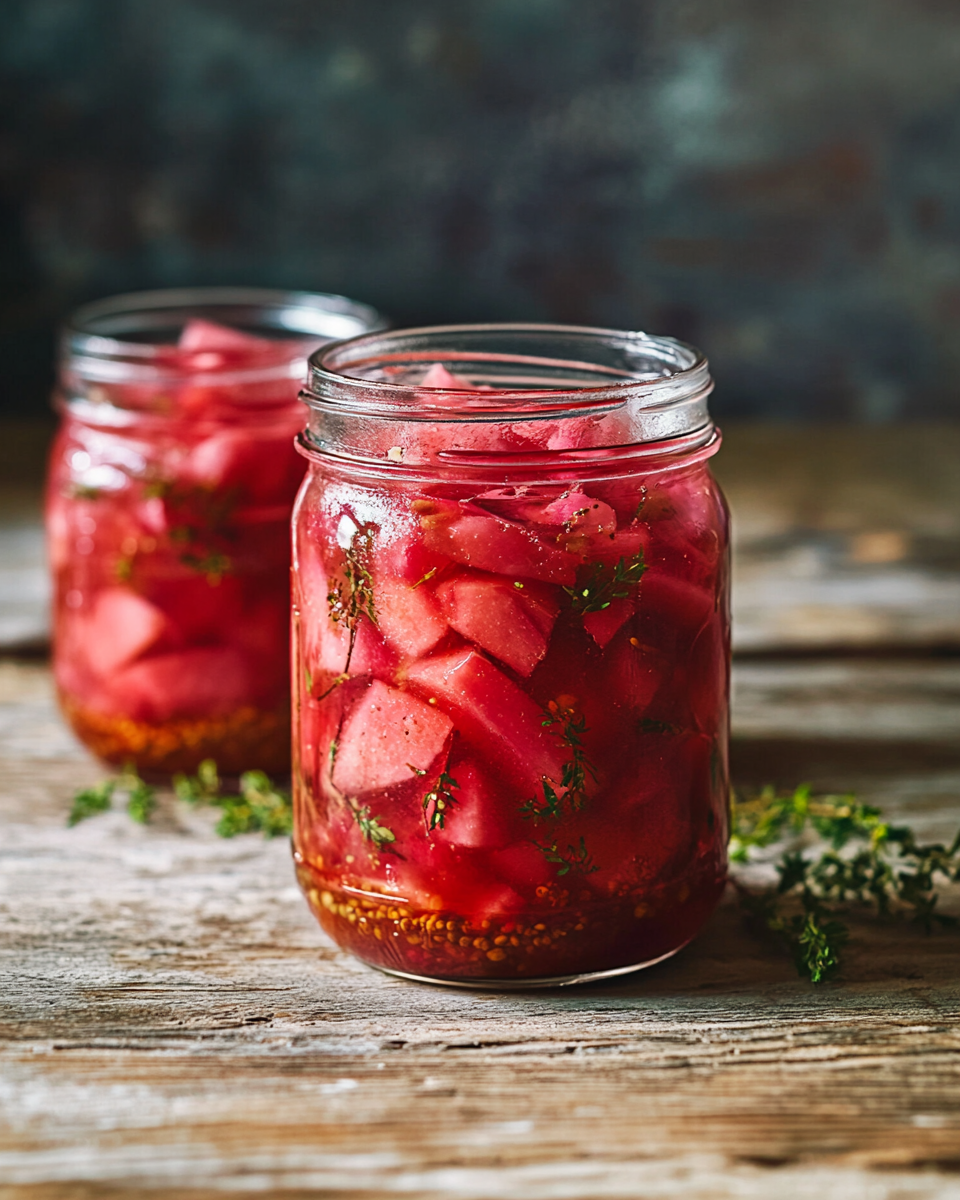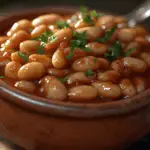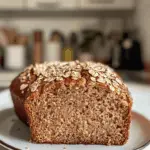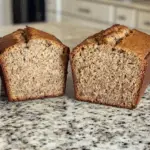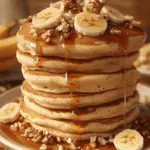This old-fashioned pickled rhubarb recipe captures the tart and tangy flavors of fresh rhubarb preserved in a sweet and spiced vinegar brine. It makes a delightful condiment or side that pairs well with meats, cheeses, and salads, adding a bright, zesty touch to any meal.
FULL RECIPE
Ingredients
- 4 cups rhubarb, cut into 2-inch pieces
- 1 ½ cups white vinegar
- 1 cup granulated sugar
- 1 tablespoon salt
- 1 teaspoon mustard seeds
- 1 teaspoon whole cloves
- 1 cinnamon stick
- ½ teaspoon ground ginger
Directions
- Wash and trim the rhubarb, then cut it into 2-inch pieces.
- In a large saucepan, combine vinegar, sugar, salt, mustard seeds, cloves, cinnamon stick, and ground ginger. Bring to a boil, stirring until sugar dissolves.
- Add rhubarb to the boiling brine and simmer gently for 5 minutes until the rhubarb is tender but still holds its shape.
- Remove from heat and let cool slightly. Remove the cinnamon stick and cloves if preferred.
- Transfer the rhubarb and liquid into sterilized jars, seal tightly, and refrigerate. Allow to pickle for at least 24 hours before serving.
Nutritional Information
- Calories: 60
- Carbohydrates: 15g
- Sugars: 14g
- Fiber: 1g
- Protein: 0.3g
- Fat: 0g
- Sodium: 300mg
History and Tradition of Pickled Rhubarb
Pickled rhubarb is a traditional preserve that dates back centuries, originating from regions where rhubarb thrived and preservation was essential for enjoying seasonal produce year-round. In many cultures, pickling was a method used not only for flavor but also to extend the shelf life of fruits and vegetables before refrigeration was common. This recipe reflects old-fashioned culinary wisdom, combining tart rhubarb with a sweet and spiced vinegar brine to create a unique balance of flavors cherished by generations.
The Role of Rhubarb in Culinary Practices
Rhubarb has long been valued for its tartness and versatility. While often associated with desserts like pies and crumbles, its ability to pair well with savory and tangy elements makes it an excellent candidate for pickling. The stalks’ firm texture holds up well in acidic environments, allowing the rhubarb to maintain a pleasant bite even after being preserved.
Health Benefits of Rhubarb
Rhubarb is a low-calorie vegetable packed with antioxidants, vitamins, and minerals such as vitamin K, calcium, and potassium. Its fiber content supports digestive health, while antioxidants help combat inflammation and oxidative stress. When pickled, many of these benefits remain, though the sugar and salt content should be consumed in moderation.
The Science Behind Pickling
Pickling uses vinegar or fermentation to create an acidic environment that inhibits bacterial growth. This preservation method enhances the flavor and texture of rhubarb while ensuring safety and longevity. The combination of vinegar and sugar balances the tartness of rhubarb, creating a harmonious taste profile that is both sharp and sweet.
Vinegar Types and Their Impact
Different types of vinegar can be used in pickling, each imparting unique flavors. White vinegar is common for its clean and sharp acidity, but apple cider vinegar or malt vinegar can add depth and complexity. The choice of vinegar influences the final taste and aroma of pickled rhubarb.
Spices and Flavor Enhancers
The use of mustard seeds, cloves, cinnamon, and ginger in this recipe adds warmth and complexity. These spices not only complement the rhubarb’s natural tartness but also contribute subtle layers of flavor that evolve over time. They provide aromatic richness that transforms a simple preserve into a gourmet condiment.
Texture and Consistency Considerations
Achieving the right texture in pickled rhubarb is crucial. The rhubarb should remain firm enough to offer a satisfying bite while being tender enough to absorb the brine’s flavors. Cooking time and the size of the rhubarb pieces are key factors in reaching this balance.
Pairing Pickled Rhubarb with Foods
Pickled rhubarb’s bright acidity makes it a versatile accompaniment to a variety of dishes. It pairs exceptionally well with rich meats like pork and lamb, cutting through their fattiness. It also works beautifully alongside cheeses, adding a contrasting tartness that enhances both textures.
Seasonality and Availability
Rhubarb is typically in season during the spring and early summer, making fresh pickled rhubarb a perfect way to capture and extend its availability. Pickling allows you to enjoy the flavors of spring rhubarb even when it’s out of season.
Storing and Shelf Life
Proper storage is vital for maintaining the quality of pickled rhubarb. Refrigerated pickles can last several weeks to months if sealed well. The acidity and sugar also act as natural preservatives, but it’s best to monitor for any signs of spoilage.
Variations of Pickled Rhubarb
This recipe can be adapted with variations such as adding chili flakes for heat, substituting spices, or experimenting with sweeteners like honey or maple syrup. Each variation alters the flavor profile, allowing for personalized twists on a classic.
Cultural Significance in Different Regions
In various cultures, pickled rhubarb has different roles. In some European countries, it’s a staple in springtime celebrations or served alongside traditional holiday dishes. Understanding these cultural nuances adds richness to the story of this humble preserve.
Nutritional Impact of Pickling
While pickling adds sugar and salt, which should be consumed in moderation, it also preserves many of rhubarb’s nutrients. The acidic environment may even enhance the bioavailability of certain compounds, making pickled rhubarb a flavorful yet nutritious addition to meals.
Cooking Tips for Perfect Pickled Rhubarb
Key tips include cutting rhubarb uniformly for even cooking, not overcooking to avoid mushiness, and ensuring the brine covers the rhubarb completely to prevent spoilage. Using sterilized jars and utensils also contributes to the safety and longevity of the pickle.
How Pickled Rhubarb Enhances Meal Presentation
Beyond flavor, pickled rhubarb adds vibrant color and texture contrast to plates. Its pink hue and glossy appearance make it an attractive garnish or side, elevating the visual appeal of simple meals and gourmet dishes alike.
The Role of Sugar in Pickling
Sugar balances the acidity of vinegar and the tartness of rhubarb, creating a mellow and approachable flavor. The amount of sugar can be adjusted to taste, allowing for sweeter or more tangy outcomes depending on preference.
Environmental Benefits of Home Pickling
Making pickled rhubarb at home reduces food waste by preserving seasonal produce and minimizes reliance on commercially processed foods. It also allows control over ingredients, reducing preservatives and artificial additives.
Common Mistakes to Avoid
Overcooking rhubarb, insufficient sterilization of jars, and improper sealing can lead to poor texture, spoilage, or unsafe preserves. Following precise methods and handling with care ensures the best results.
Serving Suggestions and Recipes Using Pickled Rhubarb
Pickled rhubarb can be used as a tangy topping for sandwiches, mixed into salads, or served alongside roasted meats. It also works well chopped into grain bowls or blended into sauces for an unexpected zing.
Conclusion
Pickled rhubarb is a delightful blend of tartness, sweetness, and spice, rooted deeply in tradition yet versatile enough for modern kitchens. Its unique flavor profile enhances a wide range of dishes, and its preservation technique offers a practical way to enjoy seasonal rhubarb year-round. Whether served as a condiment, garnish, or ingredient, pickled rhubarb brings a burst of flavor and color that brightens any meal. Embracing this old-fashioned recipe not only honors culinary heritage but also invites creativity and healthful enjoyment in everyday cooking.

